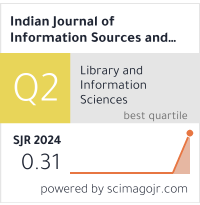Exploring the Factors Influencing Usage Behavior of the Digital Library Remote Access (DLRA) Facility in a Private Higher Education Institution in India
DOI:
https://doi.org/10.51983/ijiss-2024.14.1.4033Keywords:
Digital Library, Remote Access, Social Influence, Hedonism, Habit, Behavioral Intention, Usage BehaviorAbstract
Digitalization has transformed the world and empowered education across the globe alike. Digital Library Remote Access (DLRA) facilities have empowered students, researchers and academicians to have uninterrupted and complete access to literature and scientific information on finger tips through a single window. In order to understand the factors influencing the digital library usage in a private Higher Education Institution of Eminence in India, the study employs non-probability sampling, convenience sample of 400 researchers and students of the deemed to be university. The results of the investigation substantiates that habit plays a crucial role in ascertaining the behavioral intention and the usage behavior of DLRA technology.
References
Adams, D. A., Nelson, R. R., & Todd, P. A. (1992). Perceived usefulness, ease of use, and usage of information technology: A replication. MIS Quarterly, 16(2), 227-247. https://www.jstor.org/stable/249577.
Ahmad, S. (2020). Digital initiatives for access and quality in higher education: An overview. Retrieved from https://gnanaganga.infilibnet.ac.in:8080/jspui/handle/123456789/1909.
Alhadiah, A. (2023). Undergraduate EFL Learners’ Use and Acceptance of Mobile-Assisted Learning: A Structural Equation Modeling Approach. World Journal of English Language, 13(3), 253-253. https://ideas.repec.org/a/jfr/wjel11/v13y2023i3p253.html.
Ali, W. (2020). Online and remote learning in higher education institutes: A necessity in light of COVID-19 pandemic. Higher Education Studies, 10(3), 16-25. https://eric.ed.gov/?id=ej1259642.
AlQashouti, N., YAqot, M., Franzoi, R. E., & Menezes, B. C. (2023). Education System Resilience during the COVID-19 Pandemic-Review and Perspective. Education Sciences, 13(9), 902. https://www.mdpi.com/2227-7102/13/9/902.
Amankwah-Amoah, J., Khan, Z., Wood, G., & Knight, G. (2021). COVID-19 and digitalization: The great acceleration. Journal of Business Research, 136, 602-611. https://www.sciencedirect.com/science/article/pii/S0148296321005725.
Anderson, M. C., York, C. S., Hodge-Zickerman, A., Park, Y. S., & Rhode, J. (2024). Empowering Medical Educators: A UTAUT Analysis of Technology Adoption in Inquiry-Based Learning. Technology, Knowledge and Learning, 1-31. https://doi.org/10.1007/s10758-023-09709-y.
Anthony Jnr, B., & Noel, S. (2021). Examining the adoption of emergency remote teaching and virtual learning during and after COVID-19 pandemic. International Journal of Educational Management, 35(6), 1136-1150. https://eric.ed.gov/?id=EJ1313324.
Assaker, G. (2020). Age and gender differences in online travel reviews and user-generated content (UGC) adoption: Extending the technology acceptance model (TAM) with credibility theory. Journal of Hospitality Marketing & Management, 29(4), 428-449. https://doi.org/10.1080/19368623.2019.1653807.
Asogwa, B. E., Asadu, B. U., Ezema, J. U., & Ugwuanyi, F. C. (2014). Use of ServQUAL in the evaluation of service quality of academic libraries in developing countries. Library Philosophy and Practice. Retrieved from https://digitalcommons.unl.edu/libphilprac/1158/.
Baishya, K., & Samalia, H. V. (2020). Extending unified theory of acceptance and use of technology with perceived monetary value for smartphone adoption at the bottom of the pyramid. International Journal of Information Management, 51, 102036. https://doi.org/10.1016/j.ijinfomgt.2019.11.004.
Bhati, P., & Kumar, I. (2020). Role of library professionals in a pandemic situation like COVID-19. International Journal of Library and Information Studies, 10(2), 33-48. https://www.researchgate.net/publication/342697905_Role_of_Library_ Professionals_in_a_Pandemic_Situation_Like_COVID-19_Pankaj_Bhati.
Bygstad, B., Øvrelid, E., Ludvigsen, S., & Dæhlen, M. (2022). From dual digitalization to digital learning space: Exploring the digital transformation of higher education. Computers & Education, 182, 104463. https://www.sciencedirect.com/science/article/pii/S 0360131522000343.
Carlsson, H., & Tongren, T. (2020). Understanding library users via surveys and other methods – best practices for evidence-based library development. Journal of Library Administration, 60(8), 925-944. https://doi.org/10.1080/01930826.2020.1820276.
Chaudhry, N. I., Rehman, S. U., Elrehail, H., Al Masaeid, T. F., Adaileh, R., & Alzoubi, H. M. (2023). Analyzing the effect of fear and uncertainty avoidance on use behavior of learning management system: Post COVID-19 era. International Journal of Information Management Data Insights, 3(2), 100197. https://doi.org/10.1016/j.jjimei.2023.100197.
Ćirić, J., & Ćirić, A. (2021). The impact of the COVID-19 pandemic on digital library usage: a public library case study. Journal of Web Librarianship, 15(2), 53-68. Retrieved from https://www.tandfonline.com/doi/abs/10.1080/19322909.2021.1913465.
Cook, C., & Thompson, B. (2000). Reliability and validity of SERVQUAL scores used to evaluate perceptions of library service quality. The Journal of Academic Librarianship, 26(4), 248-258. Retrieved from https://eric.ed.gov/?id=ED435671.
Davis, F. D. (1989). Perceived usefulness, perceived ease of use, and user acceptance of information technology. MIS Quarterly, 13(3), 319-340. Retrieved from https://www.jstor.org/stable/249008.
Dhiman, N., Arora, N., Dogra, N., & Gupta, A. (2020). Consumer adoption of smartphone fitness apps: an extended UTAUT2 perspective. Journal of Indian Business Research, 12(3), 363-388. https://doi.org/10.1108/JIBR-05-2018-0158
Dino, M. J. S., & de Guzman, A. B. (2015). Using partial least squares (PLS) in predicting behavioral intention for telehealth use among Filipino elderly. Educational Gerontology, 41(1), 53-68. https://doi.org/10.1080/03601277.2014.917236
Dubey, P., & Pandey, D. (2020). Distance learning in higher education during pandemic: challenges and opportunities. The International Journal of Indian Psychology, 8(2), 43-46. Retrieved from https://ijip.in/articles/0802204/.
Emon, M. M. H. (2023). Predicting Adoption Intention of ChatGPT-A Study on Business Professionals of Bangladesh. Retrieved from https://www.researchsquare.com/article/rs-3749611/latest.
Greenwood, J. T., Watson, A. P., & Dennis, M. (2011). Ten years of LibQual: A study of qualitative and quantitative survey results at the University of Mississippi 2001–2010. The Journal of Academic Librarianship, 37(4), 312-318. Retrieved from https://www.infona.pl/resource/bwmeta1.element.elsevier-8221a961-af53-3169-90b1-a0b29b81f763.
Gupta, A., Dogra, N., & George, B. (2018). What determines tourist adoption of smartphone apps? An analysis based on the UTAUT-2 framework. Journal of Hospitality and Tourism Technology, 9(1), 50-64. Retrieved from https://www.emerald.com/insight/content/doi/ 10.1108/JHTT-02-2017-0013/full/html.
Hair, J. F., Risher, J. J., Sarstedt, M., & Ringle, C. M. (2019). When to use and how to report the results of PLS-SEM. European Business Review, 31(1), 2-24. https://doi.org/10.1108/EBR-11-2018-0203
Hirschman, E. C., & Holbrook, M. B. (1982). Hedonic consumption: emerging concepts, methods and propositions. Journal of Marketing, 46(3), 92-101. Retrieved from https://journals.sagepub.com/doi/abs/10.1177/002224298204600314.
Huijts, N. M., Molin, E. J., & Steg, L. (2012). Psychological factors influencing sustainable energy technology acceptance: A review-based comprehensive framework. Renewable and Sustainable Energy Reviews, 16(1), 525-531. Retrieved from https://www.sciencedirect.com/science/article/pii/S136403211100428X.
Hussein, Z. (2017). Leading to intention: The role of attitude in relation to technology acceptance model in e-learning. Procedia Computer Science, 105, 159-164. Retrieved from https://www.sciencedirect.com/science/article/pii/S1877050917302181.
Jafarbegloo, M., Hamidy, M., Anvari, S., & FamilRohany, A. A. (2014). Quality assessment of digital library services at University of Tehran; Using the Digiqual Model. Academic Librarianship and Information Research, 48(2), 309-324. Retrieved from https://jlib.ut.ac.ir/article_53030.html?lang=en.
Joo, S., & Choi, N. (2015). Factors affecting undergraduates’ selection of online library resources in academic tasks: Usefulness, ease-of-use, resource quality, and individual differences. Library Hi Tech, 33(2), 272-291. Retrieved from https://www.emerald.com/insight/content/doi/10.1108/LHT-01-2015-0008/full/html.
Kar, S., Kar, A. K., & Gupta, M. P. (2021). Industrial internet of things and emerging digital technologies-modeling professionals’ learning behavior. IEEE Access, 9, 30017-30034. https://ieeexplore.ieee.org/abstract/document/9354166.
Kasmia, N. B., & M’hamed, H. (2023). Digitalization of higher education: Impacts on management practices and institutional development. A literature review. Conhecimento & Diversidade, 15(39), 56-82. https://doi.org/10.18316/rcd.v15i39.11135.
Kim, H. J., Mannino, M., & Nieschwietz, R. J. (2009). Information technology acceptance in the internal audit profession: Impact of technology features and complexity. International Journal of Accounting Information Systems, 10(4), 214-228. https://www.sciencedirect.com/science/article/pii/S1467089509000360.
Kool, V. K., Agrawal, R., Kool, V. K., & Agrawal, R. (2016). Technology and hedonism. In Psychology of Technology, 253-304. https://link.springer.com/chapter/10.1007/978-3-319-45333-0_6.
Kulviwat, S., C. Bruner II, G., & P. Neelankavil, J. (2014). Self-efficacy as an antecedent of cognition and affect in technology acceptance. Journal of Consumer Marketing, 31(3), 190-199. https://doi.org/10.1108/JCM-10-2013-0727.
Lee, Y. H., Hsieh, Y. C., & Hsu, C. N. (2011). Adding innovation diffusion theory to the technology acceptance model: Supporting employees’ intentions to use e-learning systems. Journal of Educational Technology & Society, 14(4), 124-137. https://www.jstor.org/stable/pdf/jeductechsoci.14.4.124.pdf.
Lehmann, T., Blumschein, P., & Seel, N. M. (2023). Accept it or forget it: Mandatory digital learning and technology acceptance in higher education. Journal of Computers in Education, 10(4), 797-817. https://doi.org/10.1007/s40692-022-00244-w.
Lin, C. H., Shih, H. Y., & Sher, P. J. (2007). Integrating technology readiness into technology acceptance: The TRAM model. Psychology & Marketing, 24(7), 641-657. https://onlinelibrary.wiley.com/doi/abs/10.1002/mar.20177.
Lu, Y., Cao, Y., Wang, B., & Yang, S. (2011). A study on factors that affect users’ behavioral intention to transfer usage from the offline to online channel. Computers in Human Behavior, 27(1), 355-364. https://doi.org/10.1016/j.chb.2010.08.013.
Macedo, I. M. (2017). Predicting the acceptance and use of information and communication technology by older adults: An empirical examination of the revised UTAUT2. Computers in Human Behavior, 75, 935-948. https://doi.org/10.1016/j.chb.2017.06.013.
Magsamen-Conrad, K., Upadhyaya, S., Joa, C. Y., & Dowd, J. (2015). Bridging the divide: Using UTAUT to predict multigenerational tablet adoption practices. Computers in Human Behavior, 50, 186-196. https://doi.org/10.1016/j.chb.2015.03.032.
Manca, S., & Delfino, M. (2021). Adapting educational practices in emergency remote education: Continuity and change from a student perspective. British Journal of Educational Technology, 52(4), 1394-1413. https://doi.org/10.1111/bjet.13098.
McCaffrey, C. (2013). LibQUAL in Ireland: Performance assessment and service improvement in Irish university libraries. The Journal of Academic Librarianship, 39(4), 347-350. https://doi.org/10.1016/ j.acalib.2012.11.036.
Mehta, D., & Wang, X. (2020). COVID-19 and digital library services–a case study of a university library. Digital Library Perspectives, 36(4), 351-363. https://doi.org/10.1108/DLP-05-2020-0030.
Momani, A. M. (2023). Testing the impact of social isolation on students’ acceptance of learning management systems after the COVID-19 crisis using a modified UTAUT model. International Journal of Online Pedagogy and Course Design (IJOPCD), 13(1), 1-17. https://doi.org/10.4018/IJOPCD.322780.
Moon, J. W., & Kim, Y. G. (2001). Extending the TAM for a World-WideWeb context. Information & Management, 38(4), 217-230. https://www.sciencedirect.com/science/article/pii/S0378720600000616.
Moorthy, K., Chun T’ing, L., Ming, K. S., Ping, C. C., Ping, L. Y., Joe, L. Q., & Jie, W. Y. (2019). Behavioral intention to adopt digital library by the undergraduates. International Information & Library Review, 51(2), 128-144. https://www.tandfonline.com/doi/abs/10. 1080/10572317.2018.1463049.
Naiich, E., Nouruzi, Y., & Hamidi, M. (2012). Digiqual a tool for assessment of the quality of digital libraries: A case study in digital library of Broujerd Islamic Azad University from users’ viewpoint. Journal of Knowledge Studies, 5(17), 85-104. https://qje.ntb.iau.ir/ article_520523.html?lang=en.
Nikou, S. A., & Economides, A. A. (2017). Mobile-based assessment: Investigating the factors that influence behavioral intention to use. Computers & Education, 109, 53-73. https://doi.org/10.1016/j.com pedu.2017.02.005.
Oliveira, G., Grenha Teixeira, J., Torres, A., & Morais, C. (2021). An exploratory study on the emergency remote education experience of higher education students and teachers during the COVID‐19 pandemic. British Journal of Educational Technology, 52(4), 1357-1376. https://pubmed.ncbi.nlm.nih.gov/34219758/.
Ouellette, J. A., & Wood, W. (1998). Habit and intention in everyday life: The multiple processes by which past behavior predicts future behavior. Psychological Bulletin, 124(1), 54.
Radina, N. K., & Balakina, J. V. (2021). Challenges for education during the pandemic: An overview of literature. Voprosy obrazovaniya / Educational Studies Moscow, (1), 178-194.
Salauddin, N., & Kumar, J. (2020). User’s Assessment on the Library Service Quality in Tagore Library, University of Lucknow, Lucknow: A study. Library Philosophy and Practice, 1-11. https://digitalcommons.unl.edu/libphilprac/4137.
Singh, S. (2022). Role of National Digital Library of India (NDLI) for facilitating open access resources (OARs): An investigation on COVID-19 research repository. Digital Library Perspectives, 38(4), 493-507. https://doi.org/10.1108/DLP-08-2021-0072.
Teo, T. (2011). Factors influencing teachers’ intention to use technology: Model development and test. Computers & Education, 57(4), 2432-2440. https://www.sciencedirect.com/science/article/pii/S0360131511001370.
Tibenderana, P., Ogao, P., Ikoja-Odongo, J., & Wokadala, J. (2010). Measuring levels of end-users’ acceptance and use of hybrid library services. International Journal of Education and Development using Information and Communication Technology, 6(2), 1F. https://eric.ed.gov/?id=EJ1084985.
Van der Heijden, H., Verhagen, T., & Creemers, M. (2003). Understanding online purchase intentions: Contributions from technology and trust perspectives. European Journal of Information Systems, 12(1), 41-48. https://www.tandfonline.com/doi/abs/10.1057/palgrave.ejis.3000445.
Venkatesh, V., & Bala, H. (2008). Technology acceptance model 3 and a research agenda on interventions. Decision Sciences, 39(2), 273-315. https://onlinelibrary.wiley.com/doi/abs/10.1111/j.1540-59 15.2008.00192.x.
Venkatesh, V., Morris, M. G., Davis, G. B., & Davis, F. D. (2003). User acceptance of information technology: Toward a unified view. MIS Quarterly, 425-478. https://www.jstor.org/stable/30036540.
Venkatesh, V., Thong, J. Y., & Xu, X. (2012). Consumer acceptance and use of information technology: Extending the unified theory of acceptance and use of technology. MIS Quarterly, 36(1), 157-178. https://www.jstor.org/stable/41410412.
Verplanken, B., & Aarts, H. (1999). Habit, attitude, and planned behaviour: Is habit an empty construct or an interesting case of goal-directed automaticity? European Review of Social Psychology, 10(1), 101-134. https://www.tandfonline.com/doi/abs/10.1080/14792779943000035.
Vongjaturapat, S., & Chaveesuk, S. (2013, June). Mobile technology acceptance for library information service: A theoretical model. In Information Society (i-Society), 2013 International Conference on (290-292). IEEE. https://ieeexplore.ieee.org/document/6636393.
Wang, F., Wijaya, T. T., Habibi, A., & Liu, Y. (2022). Predictors influencing urban and rural area students to use tablet computers as learning tools: Combination of UTAUT and TTF models. Sustainability, 14(21), 13965. https://www.mdpi.com/2071-1050/14/21/13965.
Wu, J., & Liu, D. (2007). The effects of trust and enjoyment on intention to play online games. Journal of Electronic Commerce Research, 8(2). http://jecr.org/sites/default/files/08_2_p02.pdf.
Wu, C. H., Yuan, Y. H., & Tsai, S. B. (2020). Using the DEMATEL model to expose core causal items of LibQUAL for improving library service quality: From the perspective of big data. Soft Computing, 24, 5729-5739. https://ouci.dntb.gov.ua/en/works/4NZyZzj4/.
Yang, H. D., & Yoo, Y. (2004). It’s all about attitude: Revisiting the technology acceptance model. Decision Support Systems, 38(1), 19-31. https://www.sciencedirect.com/science/article/pii/S0167923603000629.
Yu, K., & Huang, G. (2020). Exploring consumers’ intent to use smart libraries with technology acceptance model. The Electronic Library, 38(3), 447-461. https://www.emerald.com/insight/content/doi/10.1108/EL-08-2019-0188/full/html.
Yu, Z., Xu, W., & Yu, L. (2022). Constructing an online sustainable educational model in COVID-19 pandemic environments. Sustainability, 14(6), 3598. https://www.mdpi.com/2071-1050/14/6/3598.
Zainab, B., Awais Bhatti, M., & Alshagawi, M. (2017). Factors affecting e-training adoption: An examination of perceived cost, computer self-efficacy and the technology acceptance model. Behaviour & Information Technology, 36(12), 1261-1273. https://www.tandfonline.com/doi/abs/10.1080/0144929X.2017.1380703.
Downloads
Published
How to Cite
Issue
Section
License
Copyright (c) 2024 The Research Publication

This work is licensed under a Creative Commons Attribution-NonCommercial-NoDerivatives 4.0 International License.









